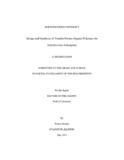Please use this identifier to cite or link to this item:
http://archive.nnl.gov.np:8080/handle/123456789/387| Title: | Design and synthesis of tunable porous organic polymers for selective gas adsorption |
| Authors: | Pandey, Prativa |
| Keywords: | Microporous organic polymers microporous porous organic polymers |
| Issue Date: | 24-Nov-2017 |
| Abstract: | Porous organic polymers (POPs) have been regarded as promising materials for gas storage due to their easy preparation, large surface areas, and tunable pore size and functionalities. This thesis reports the design and synthesis of three classes of POPs from a variety of planar and non-planar building blocks, thus enabling the tuning of their pore properties (surface area, pore volume, pore diameter, etc.) for gas adsorption. One class of POPs was synthesized via Schiff-base condensation between the planar building block 1,3,5- triformylbenzene and aryldiamines. This facile, one-pot approach resulted in quantitative yields of imine-linked POPs that can incorporate several functional groups, including amine, iodine, and hydroxyl moieties, which interact differently with gas molecules like N2, H2, and CO2. These POPs exhibited good specific surface areas (up to 1500 m2 g-1), high isosteric heats of H2 adsorption (Qst, up to 8.2 kJ mol-1), as well as preferential adsorption of CO2 over N2 due to favorable interactions with functional groups. Based on the knowledge of POP synthesis and pore tuning obtained from imine-linked POPs, more robust, nitrogen-rich, “click-based” POPs were synthesized via copper-catalyzed azide-alkyne coupling (CuAAC) between two tetrahedral building blocks. By varying the amount of active catalyst in POP synthesis, a series of POPs with differing pore volumes and surface areas were obtained. These POPs exhibited H2 uptakes and heats of adsorption that are similar to those for imine-linked POPs. They also displayed high CO2-uptake capacities. To gain an in-depth understanding of the roles that pore properties and chemical functionalities of POPs play on gas adsorption, highly stable melamine-based POPs containing metal-incorporation sites were next prepared from two planar building blocks. Post-synthesis modifications were employed to attach high density of coordinatively unsaturated metals in these POPs for enhanced H2 heats of adsorption. Based on the design principles learned from the aforementioned three classes of nitrogenrich POPs, the melamine-based POPs were then elaborated with several multi-aldehyde struts and found to have good CO2 adsorption. Excellent selectivities of CO2 over N2, much higher than those derived for industrially used porous carbon materials, were obtained by tuning the pore size. |
| Description: | A dissertation submitted to the graduate school in partial fulfillment of the requirements for the degree of Doctor of Philosophy, field of Chemistry, Northwestern University, Evanston, Illinois, 2013 |
| URI: | http://103.69.125.248:8080/xmlui/handle/123456789/387 |
| Appears in Collections: | 600 Technology (Applied sciences) |
Files in This Item:
| File | Description | Size | Format | |
|---|---|---|---|---|
| Prativa Pandey_PhD Thesis.pdf | 34.67 MB | Adobe PDF |  View/Open |
Items in DSpace are protected by copyright, with all rights reserved, unless otherwise indicated.